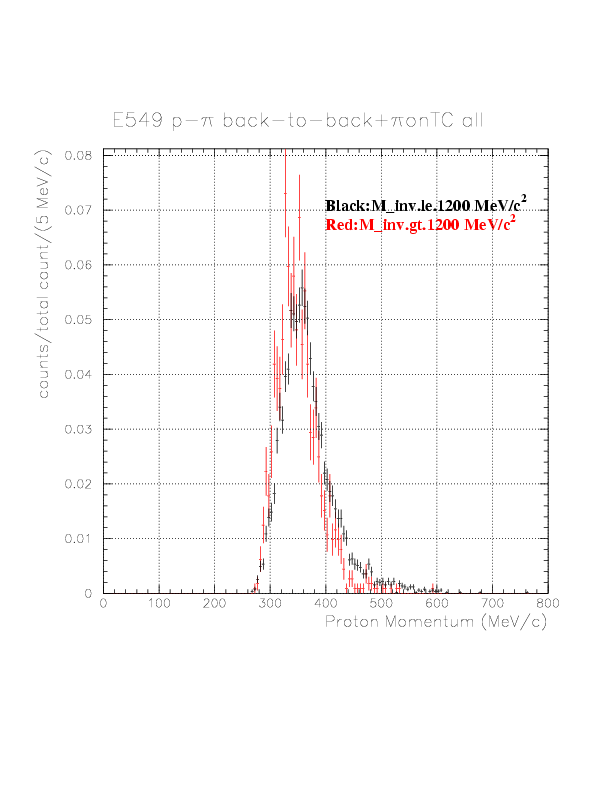Today's Progress 17. Nov. 2006
(stopped K^-, p onPB/NT:p/&pi onTC) coincidence spectrum and VcaVp selection
Method
Here, various kinds of (stopped K^-, p) coincidence spectra are shown. Here, Vca means that between BLC-VDC (i.e. that between Kaon and secondary charged particle), and the definition is now identical to that on the discussion of the neutron spectrum. Note that energy-loss correction is applied, while proton acceptance correction is not performed unless being mentioned .The events are accumulated from the Kstop-Charged triggered events, i.e. from the events on which corresponding bit is on, regardless of others.
(stopped K^-, p on PA/PB/NT:p on TC) spectra
Now we classify (stopped K^-, p onPA/PB/NT:p onTC) spectrum with
1. VcVp (Vc:direction vector of TC-detected proton Vp:direction vector of PA/PB/NT-detected proton),
2. dE/dx on TC (for the TC-detected proton momentum slection).
The definitions of "fast p" and "slow p" are as adopted for neutron spectrum analysis. We have found about 0.034 M proton coincidence proton events, out of 1.1 M inclusive events.
Distribution of VcVp for (stopped K^-, p onPA/PB/NT:p onTC) events.
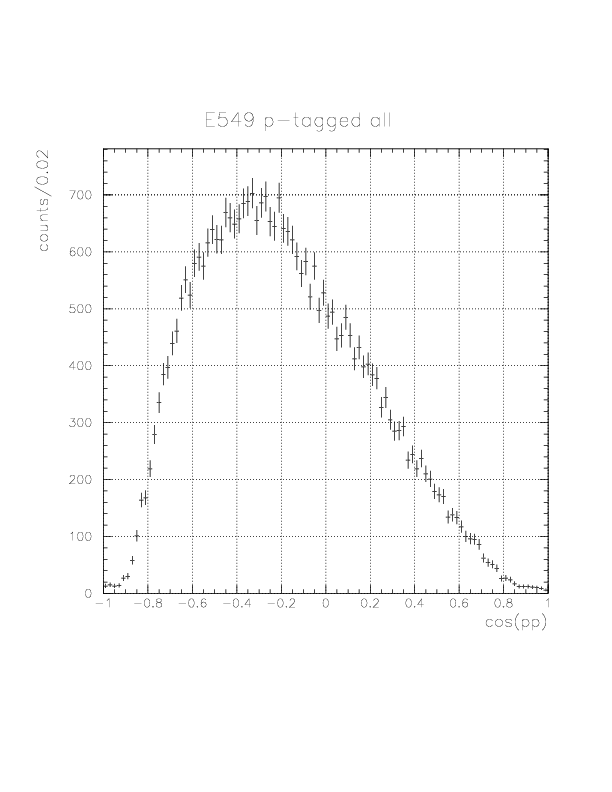
(stopped K^-, p onPA/PB/NT:p onTC) spectrum.

(stopped K^-, p onPA/PB/NT:p onTC) spectrum classified with VcVp.
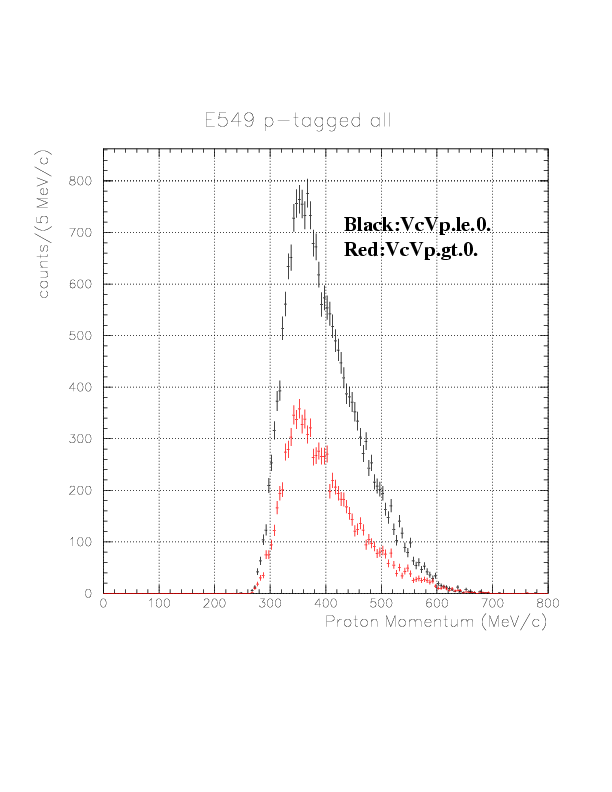
(stopped K^-, p onPA/PB/NT:p onTC) spectrum classified with TC-detected proton energy loss.
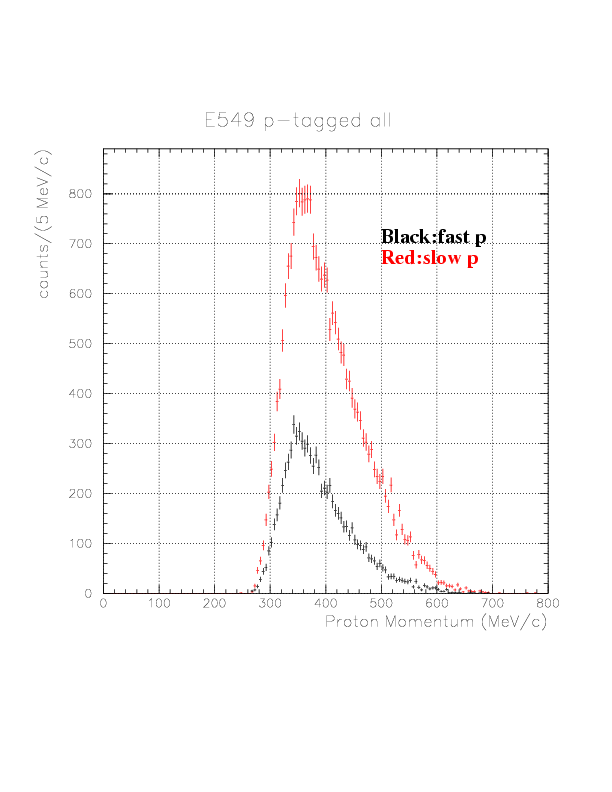
(stopped K^-, p onPA/PB/NT:fast p onTC) spectrum.
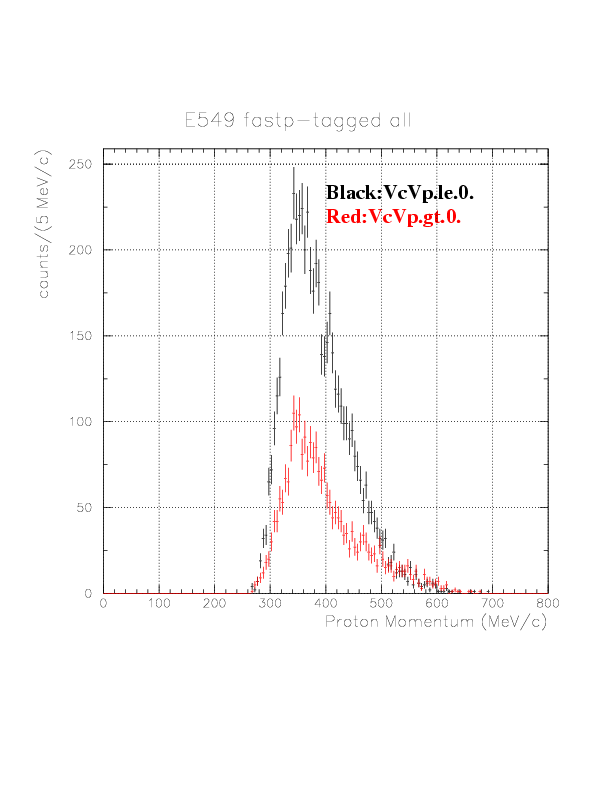
(stopped K^-, n onNT:slow p onTC) spectrum.
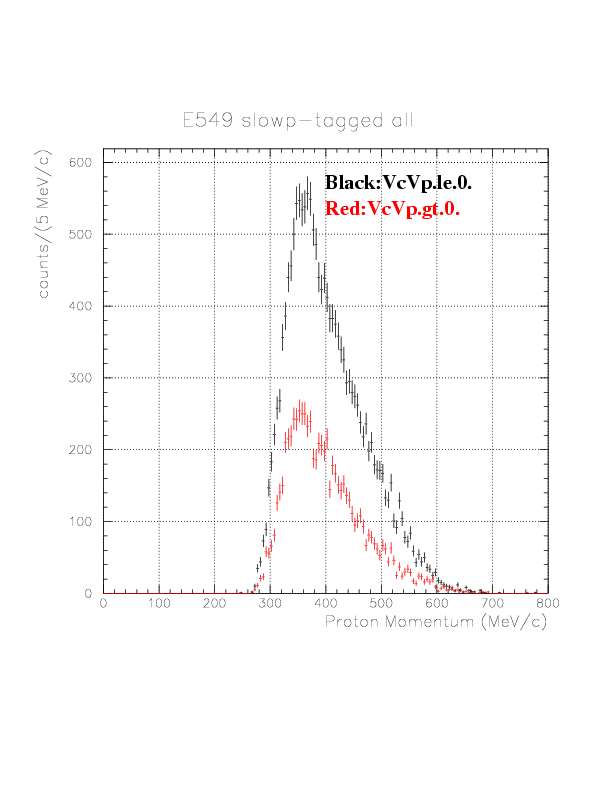
(stopped K^-, p on PA/PB/NT:&pi on TC) spectra
Now, we classify the (stopped K^-, p onPA/PB/NT:&pi onTC) spectrum with
1. VcaVp,
2. pion momentum.
First, just VcaVp selection is applied to the &pi-tagged spectrum. We have found about 0.224 M pion coincidence proton events, out of 1.1 M inclusive events.
pi-tagged VcaVp spectrum.

(stopped K^-, p onPA/PB/NT:&pi onTC) spectrum
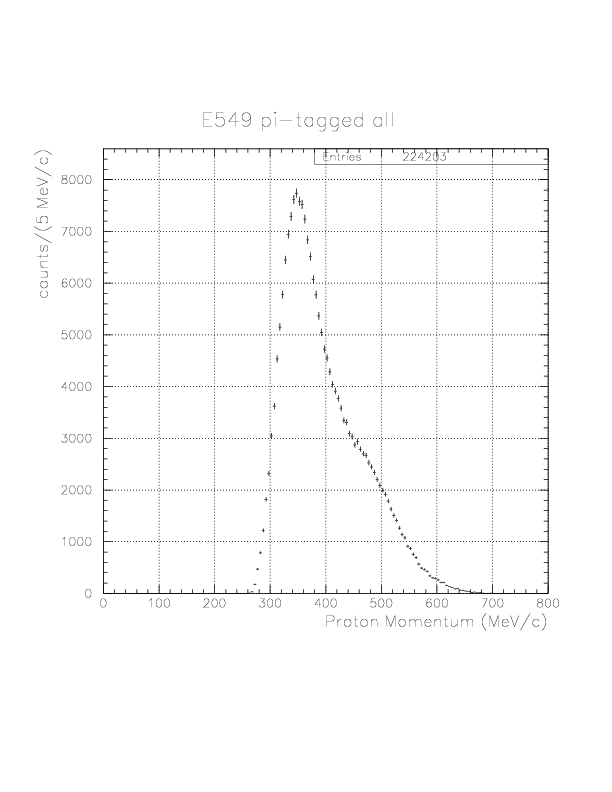
(stopped K^-, p onPA/PB/NT:&pi onTC) spectrum classified by VcaVp. For the top, green:-60~-25, red:-25~-5, black:-5~-2. For the bottom, green:25~60, red:5~25, black:2~5.


(stopped K^-, p on PA/PB/NT:&pi on TCtop:&pi on TCbottom) spectra
Here, 2-&pi coincidence proton spectrum is shown.
As is already known, non-pionic components all vanish. On the spectrum, substantial strength exists over 400 MeV/c. This should be explained by the cascade,
K^- "n" -> &Lambda &pi^- ,
&Lambda -> p &pi^- .
(stopped K^-, p onPA/PB/NT:&pi onTCtop:&pi onTCbottom).
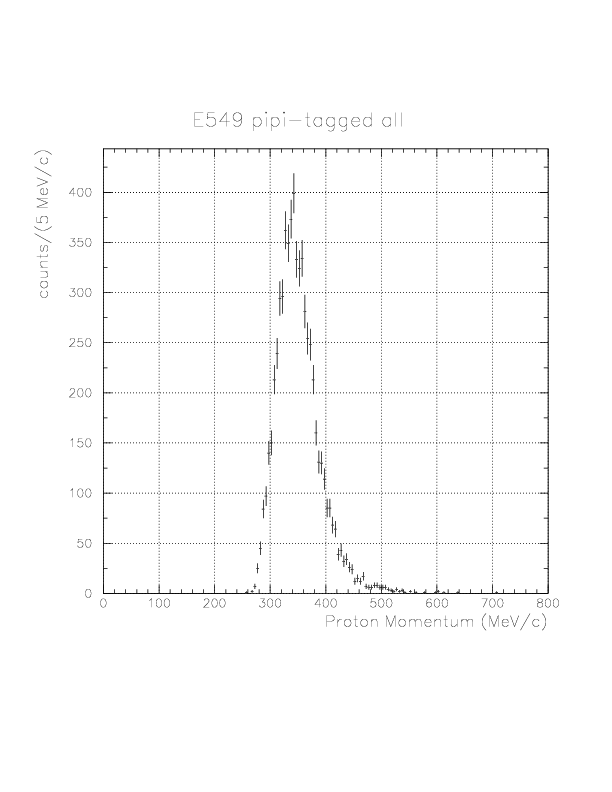
(stopped K^-, p on PA/PB/NT:slow &pi on TC) spectra
Now, slow&pi-tagged proton spectrum is shown. The definition of slowpi is kept as used for neutron spectrum analysis.
slowpi-tagged VcaVp spectrum. An intense &Lambda -decay component is seen.

(stopped K^-, p onPA/PB/NT:slow&pi onTC) spectrum
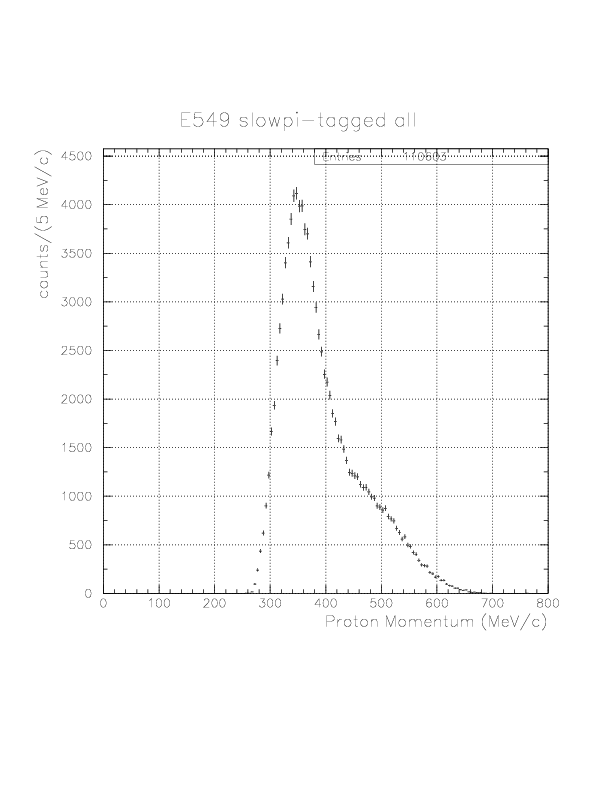
(stopped K^-, p onPA/PB/NT:slow&pi on TC) spectra classified by VcaVp. For the top, green:-60~-25, red:-25~-5, black:-5~-2. For the bottom, green:25~60, red:5~25, black:2~5.
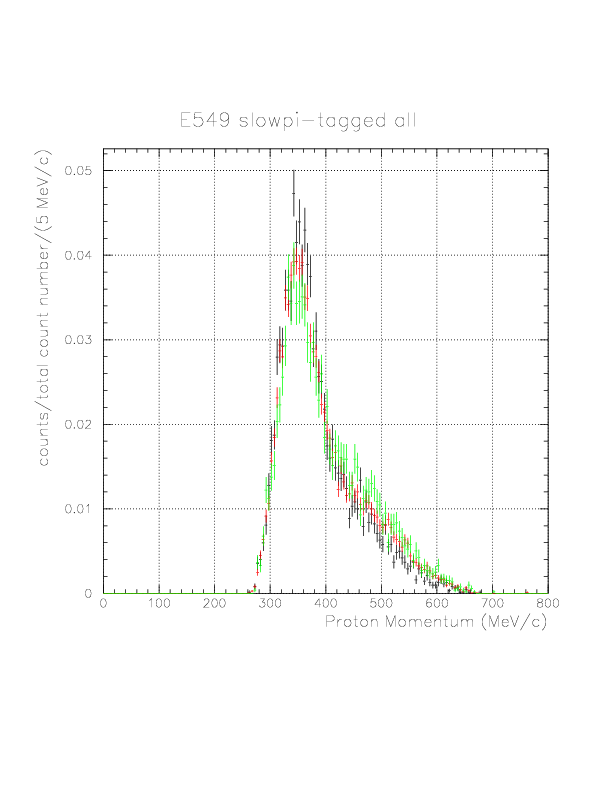
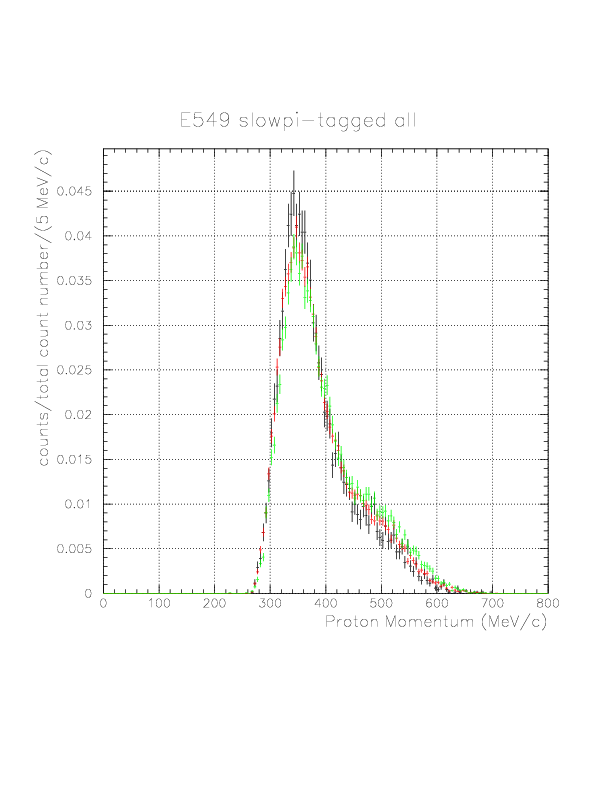
(stopped K^-, p on PA/PB/NT:fast &pi onTC) spectra
Now, fast&pi-tagged proton spectrum is shown. The definition of slowpi is kept as used for neutron spectrum analysis.
fastpi-tagged VcaVp spectrum. Now it is nearly symmetric, as is for VcaVn.

(stopped K^-, p onPA/PB/NT:fast&pi onTC) spectrum
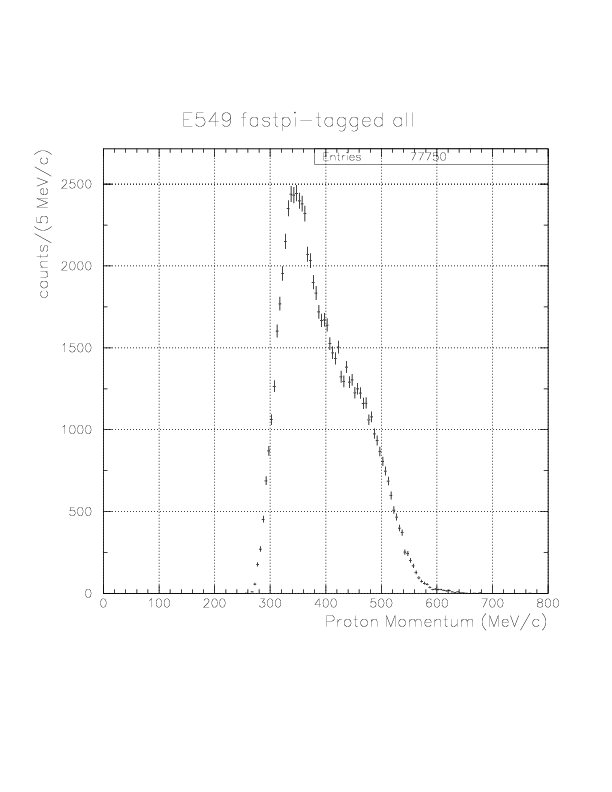
(stopped K^-, p onPA/PB/NT:fast&pi onTC) spectrum with -2. < VcaVp < 2. to search for possible hypernuclear two-body decay 4HeLambda -> 3H + p at around 510 MeV/c.
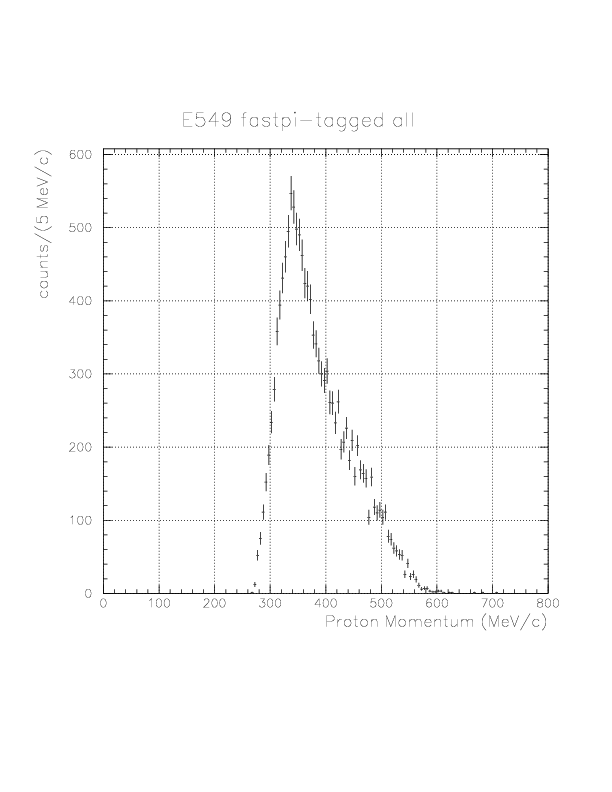
(stopped K^-, p onPA/PB/NT:fast&pi onTC) spectra classified with VcaVp. For the top, green:-60~-25, red:-25~-5, black:-5~-2. For the bottom, green:25~60, red:5~25, black:2~5.

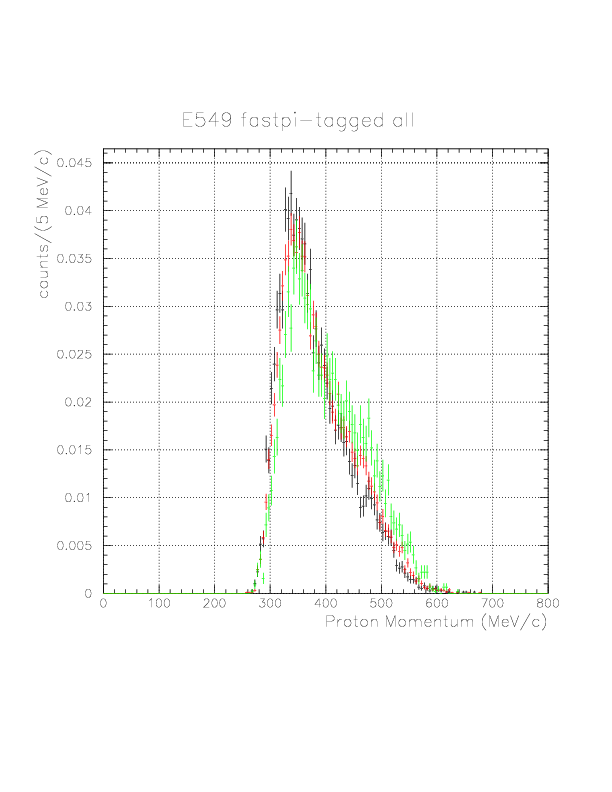
Backword(top)/Forward(bottom) comparison of the variation of the spectra related to VcaVp value.
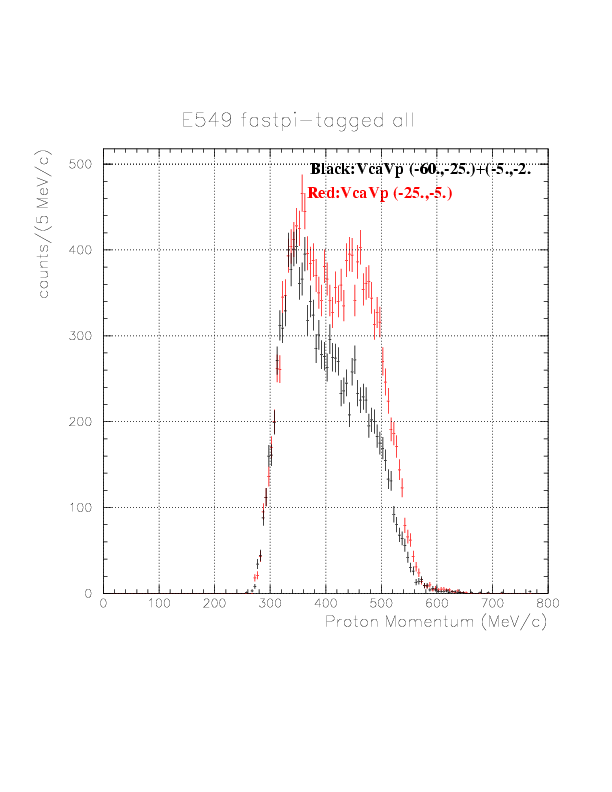
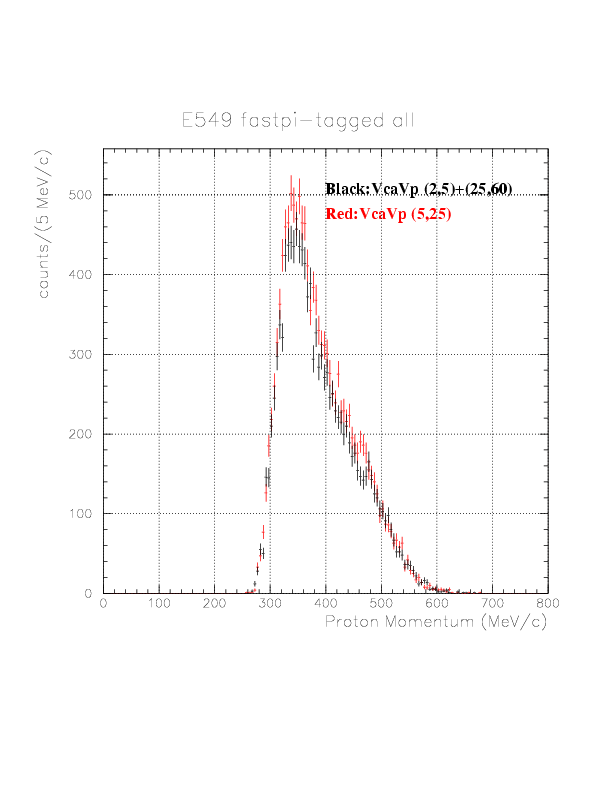
(stopped K^-, p on PA/PB/NT_L:p on PA/PB/NT_R) two proton back-to-back coincidence spectra
Here, (stopped K^-, p onPA/PB/NT_L:p onPA/PB/NT_R: (p/&pi onTC)) spectra are shown. First, the spectrum is shown without no-TC/VDC-wise requirement. It is classified by cos(pp) and counter-detected proton momentum, and shown below.
cos(pp) distribution.
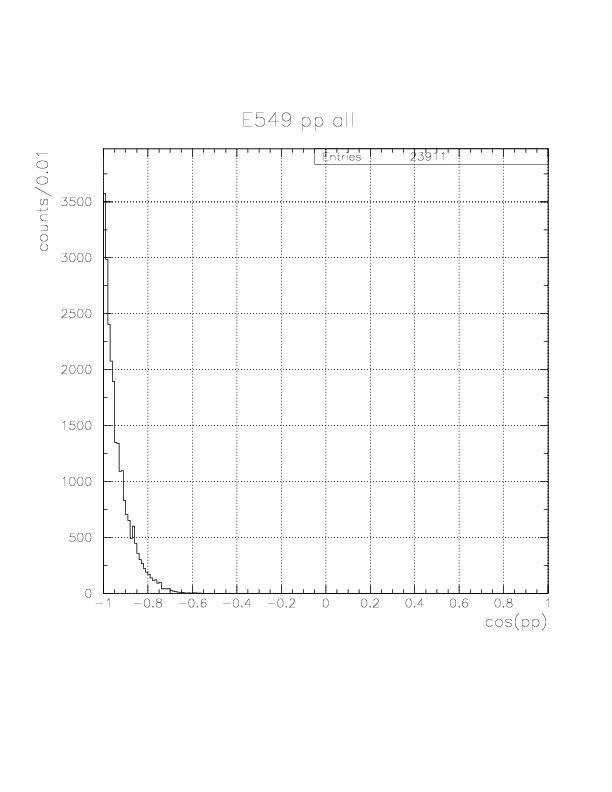
(stopped K^-, p onNT_L:p onNT_R) spectra. On the first, the spectrum is classified by cos(pp), while by counter-detected-proton momentum on the second.
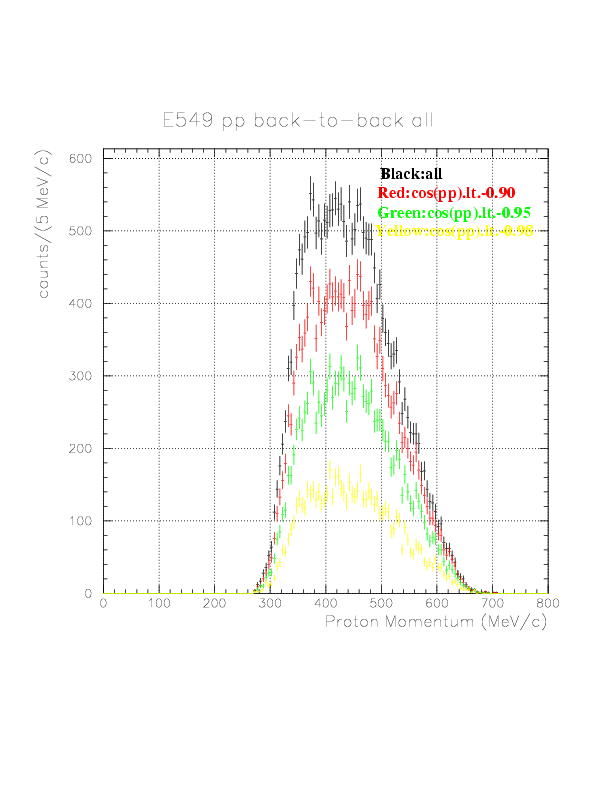

(stopped K^-, p onPA/PB/NT_L:p on PA/PB/NT_R) spectra selected by counter-detected-proton momentum AND cos(pp). The first/second/third spectra are with p_p > 300/400/500 MeV/c, respectively. Black/Red/Green/Yellow are all/cos(pp).le.-0.90/cos(pp).le.-0.95/cos(pp).le.-0.98, respectively.)
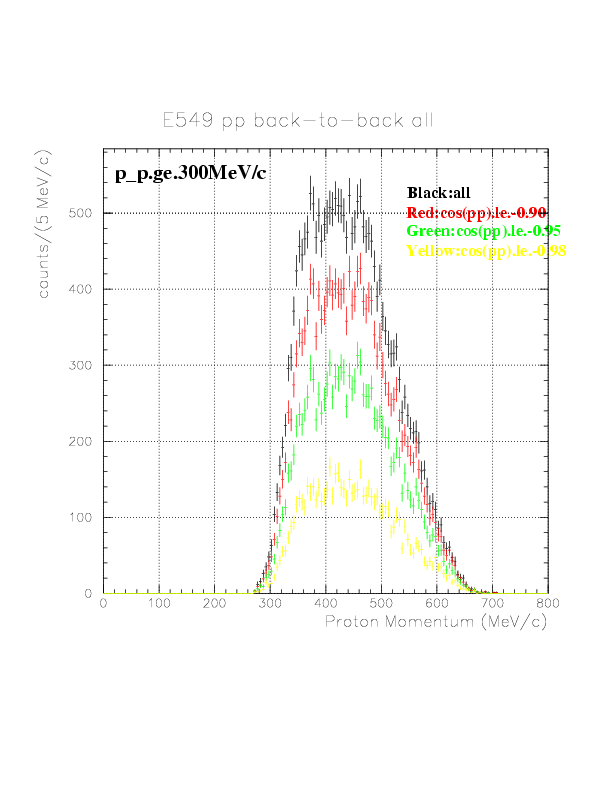
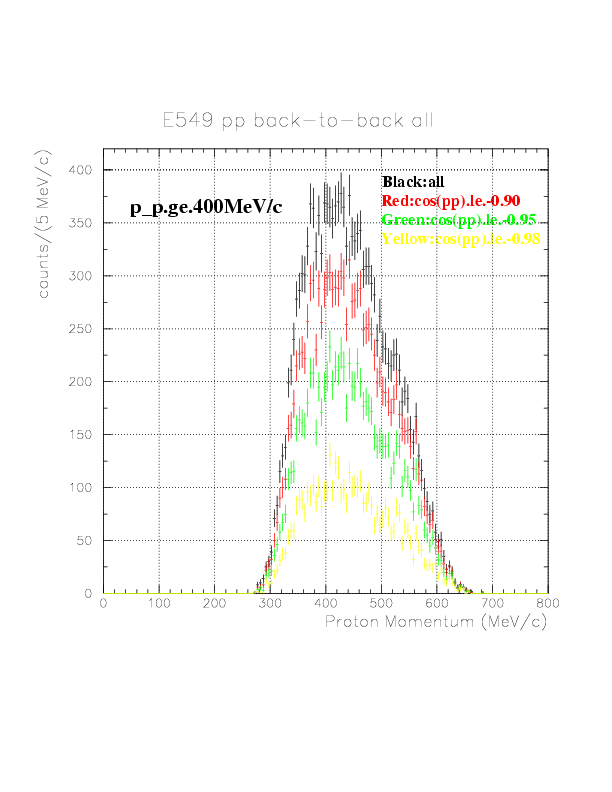

The correlation of p-p momenta is shown below.
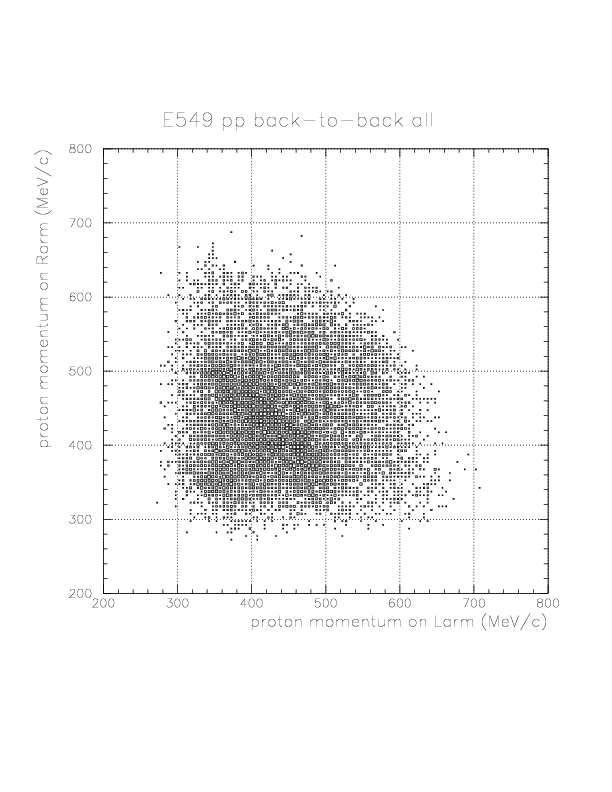
pp invariant mass spectra are shown below. A narrow peak structure is found at 2070 MeV/c^2.
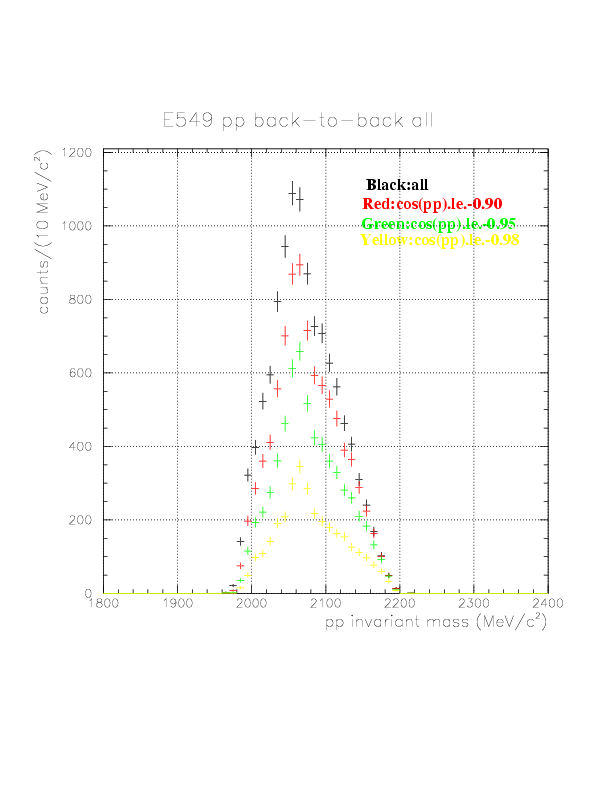
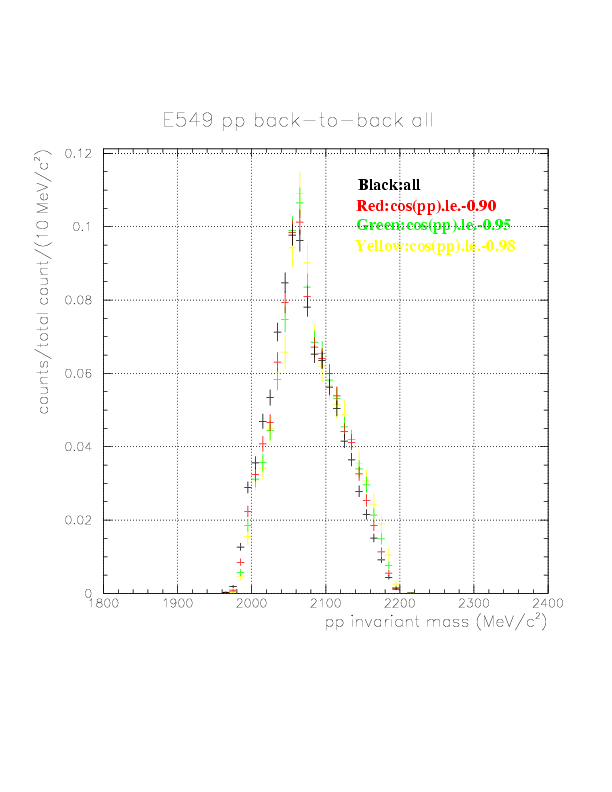
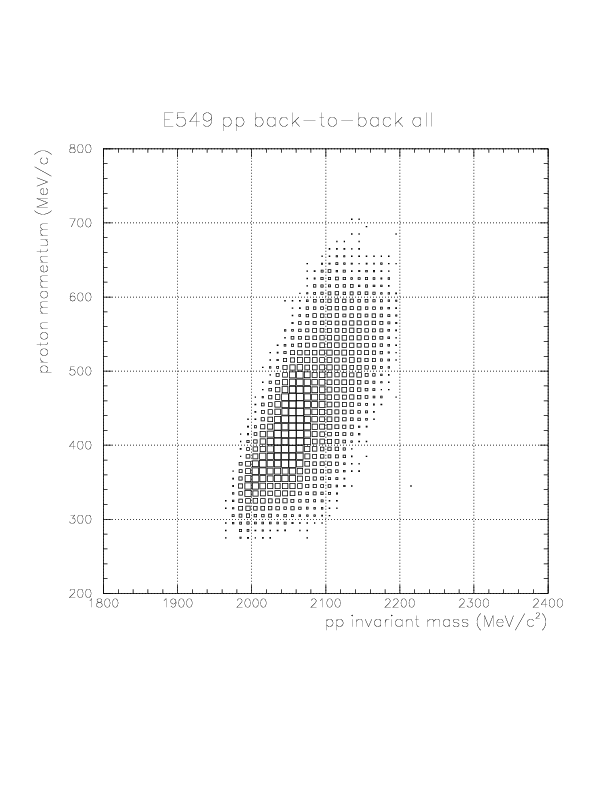
Now, we study (stopped K^-, p onNT_L:p onNT_R:&pi on TC) spectrum.
(stopped K^-, p onPA/PB/NT_L:p onPA/PB/NT_R:&pi onTC) spectra. On the first, the spectrum is classified by cos(pp), while by counter-detected-proton momentum on the second.
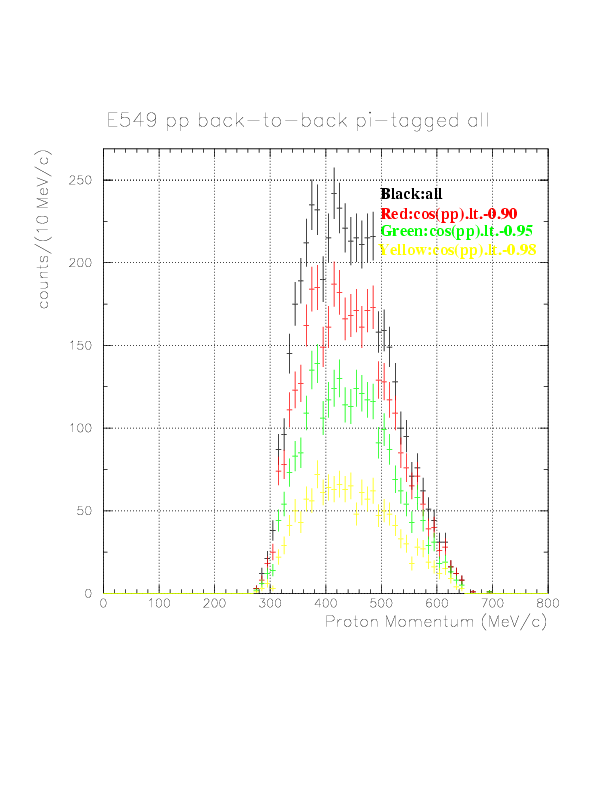
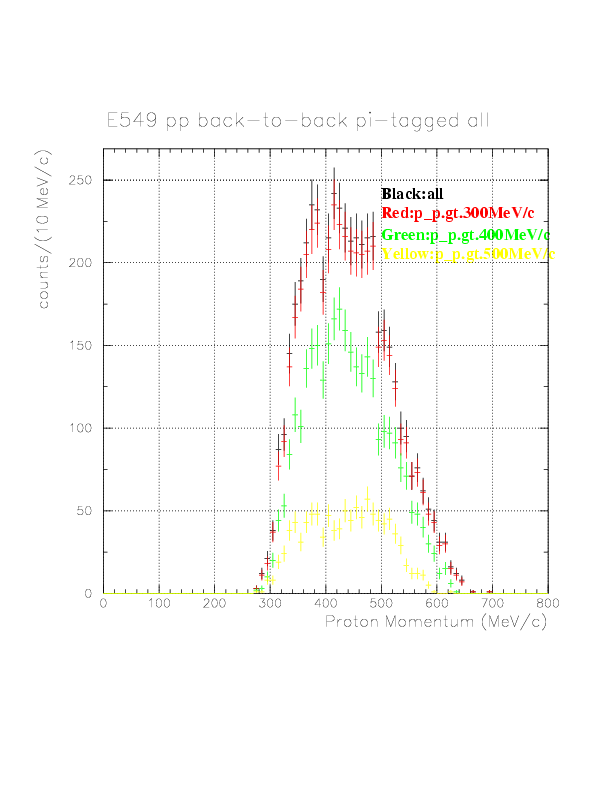
(stopped K^-, p on PA/PB/NT:&pi on PA/PB/NT) proton-pion back-to-back coincidence spectra
Here, (stopped K^-, p onPA/PB/NT:&pi onPA/PB/NT) spectra are shown. Now, (p,&pi) invariant mass analysis is feasible, and it gives a valuable information.
Definition of "&pi on PA/PB/NT events"
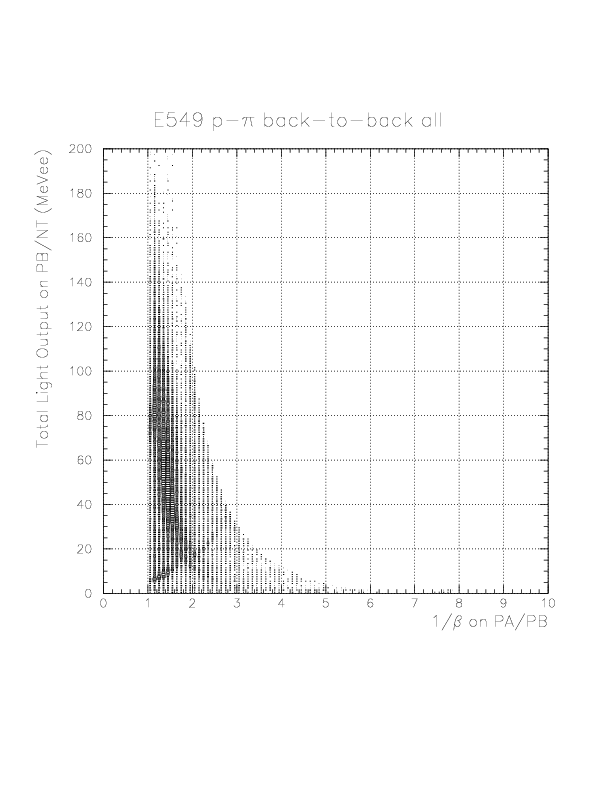
Top:p+&pi invariant mass distribution from (stopped K^-, p onPA/PB/NT:&pi onPA/PB/NT) events. It shoud be noted that the &Lambda peak which should be ~1116 MeV/c^2 is not clearly seen by this combination, because a pion from the decay of a fast &Lambda is inverse-boosted, and it cannot reach to PB. The events in which pions are forward-boosted is dropped as multi-track events. Middle:p+&pi invariant mass(x) vs pion TOF momentum(y). The peak at 1300 MeV/c^2 on the invariant mass spectrum is found to be due to decay of &Sigma. Bottom:p+&pi invariant mass(x) vs proton momentum(y). The component accompanies to the &Sigma decay end at proton momentum ~540 MeV/c.
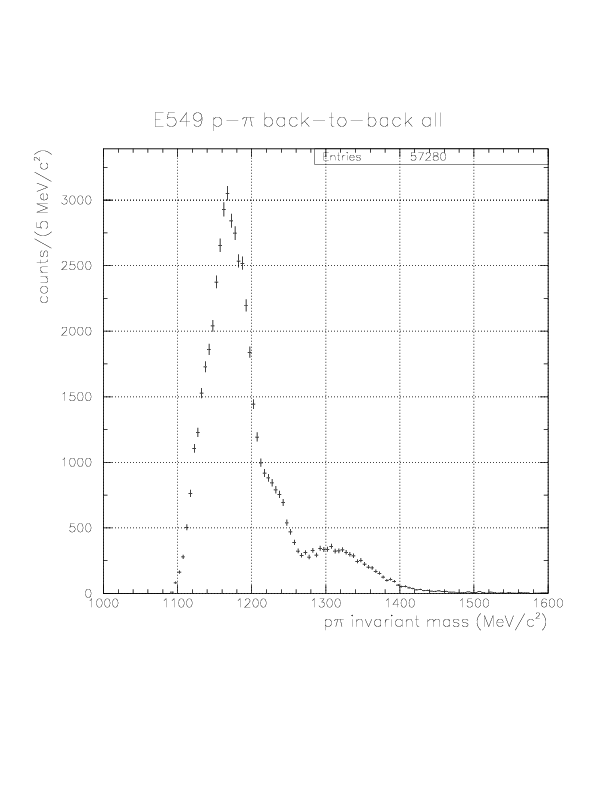
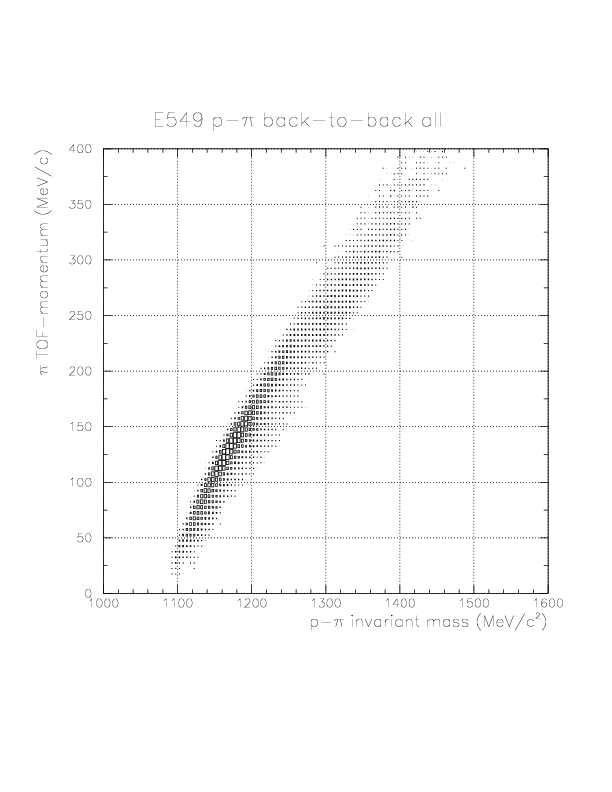

When the spectrum is classified by invariant mass, the contribution from
quasi-free &Lambda production,
K^- "n" -> (&Lambda) &pi^- ,
&Lambda -> p (&pi^-) ,
and two-nucleon absorption,
K^- "pn" -> (&Sigma^-) p ,
&Sigma^- -> (n) &pi^- ,
can be separated.
A weak contribution from
K^- "pp" -> (&Lambda) p ,
&Lambda -> (p) &pi^- ,
is also found on the correlation between invariant mass VS proton momentum.
Top:proton momenmtum spectrum from (stopped K^-, p onPA/PB/NT:&pi onPA/PB/NT) events. Bottom:invariant-mass-selected proton momentum spectra.
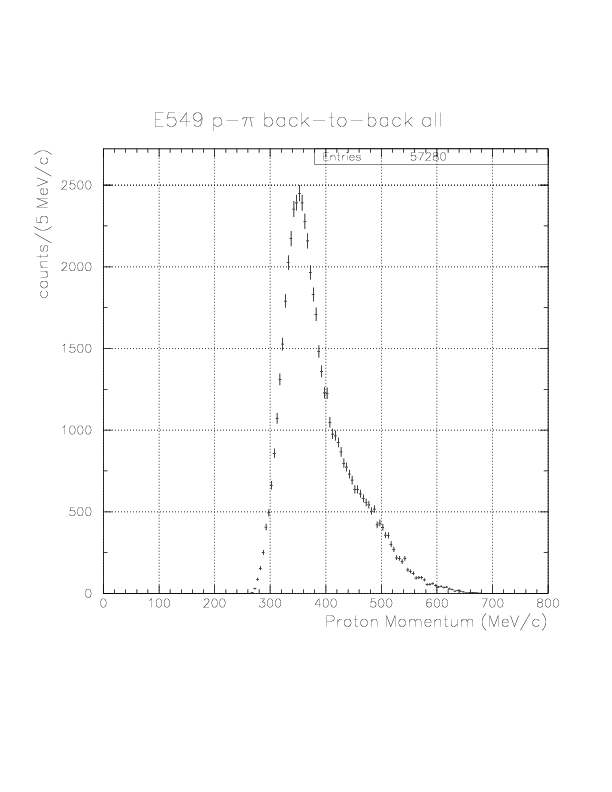

(stopped K^-, p onPA/PB/NT:&pi onPA/PB/NT:&pi onTC) proton-pion back-to-back +&pi onTC coincidence spectra
Here, (stopped K^-, p onPA/PB/NT:&pi onPA/PB/NT:&pi onTC) spectra are shown.
Top:p+&pi invariant mass distribution from (stopped K^-, p onPA/PB/NT:&pi onPA/PB/NT:&pi onTC) events. Middle:p+&pi invariant mass(x) vs pion TOF momentum(y). The peak at 1300 MeV/c^2 on the invariant mass spectrum is now dissappeared, hence it has been found to be due to non-pionic process. Bottom:p+&pi invariant mass(x) vs proton momentum(y). The component accompanies to the &Sigma decay from non-pionic process found previously, is now dissappeared.
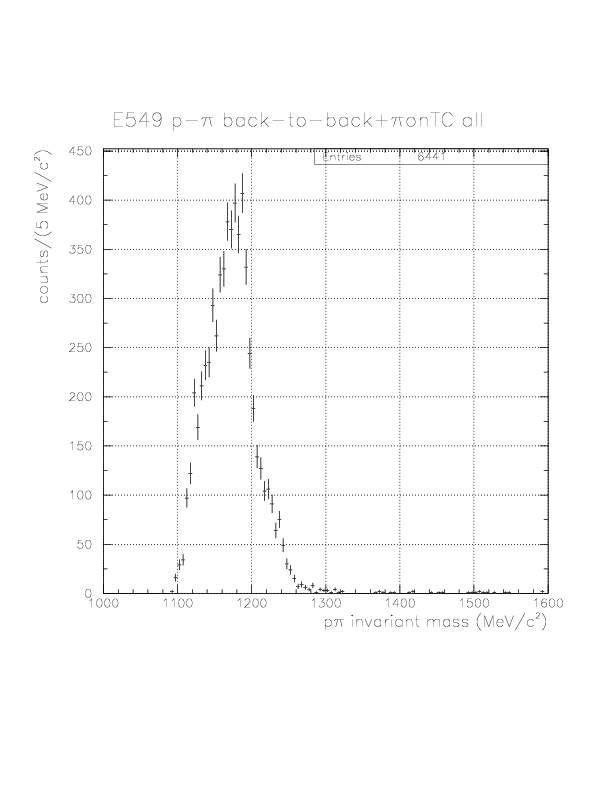

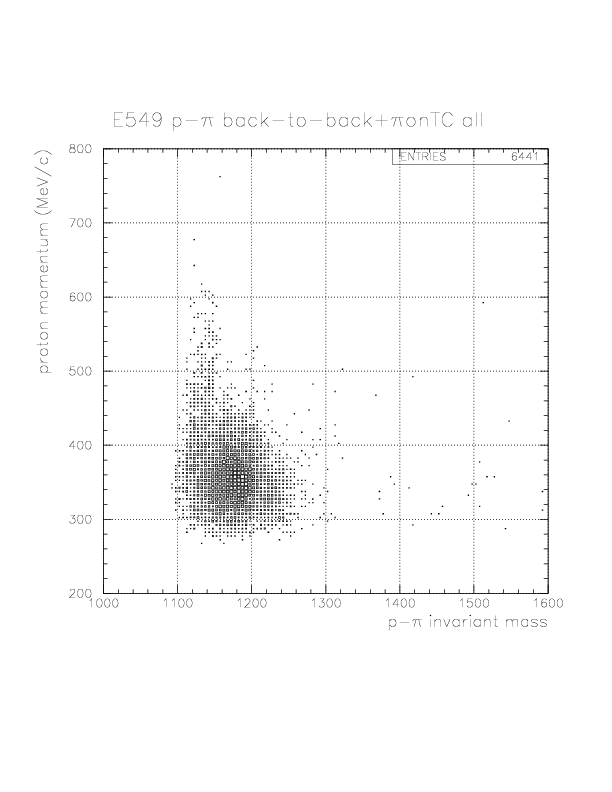
Now, the spectrum is dominated by the process,
K^- "n" -> (&Lambda) &pi^-(on PA/PB/NT) ,
&Lambda -> p(on PA/PB/NT) &pi^-(on TC) ,
and two-nucleon absorption processes,
K^- "pn" -> (&Sigma^-) p ,
&Sigma^- -> (n) &pi^- ,
and
K^- "pp" -> (&Lambda) p ,
&Lambda -> (p) &pi^- ,
are found to vanish.
Top:proton momenmtum spectrum from (stopped K^-, p onPA/PB/NT:&pi onPA/PB/NT:&pi onTC) events. Bottom:invariant-mass-selected proton momentum spectra.

